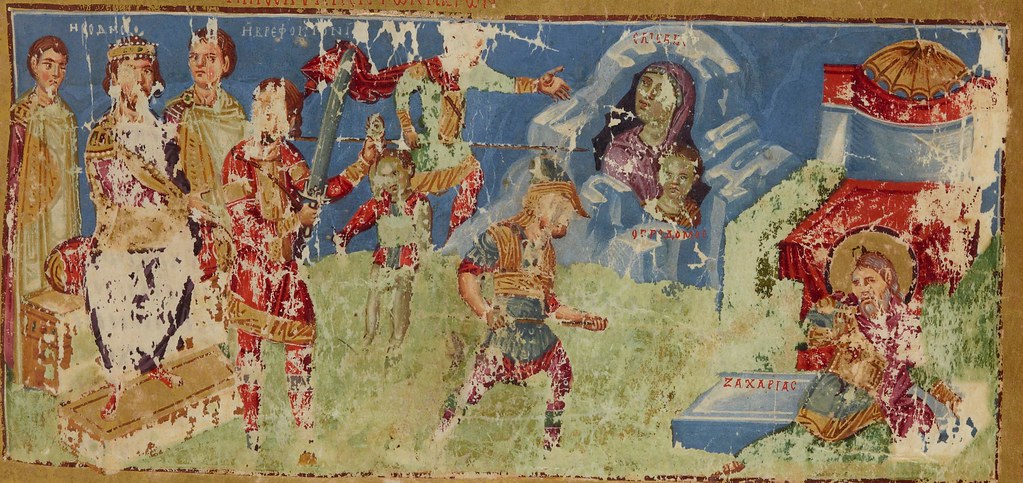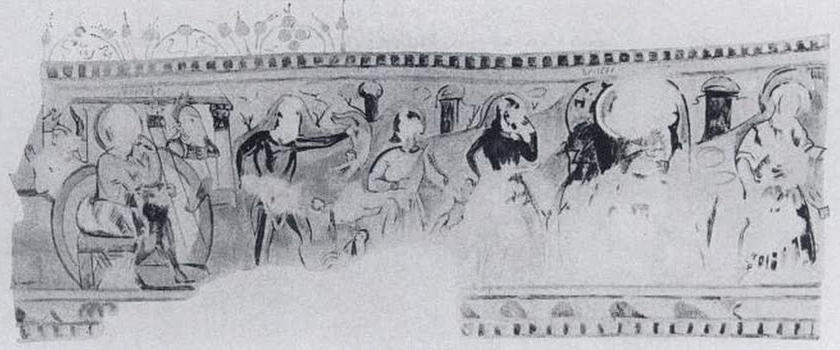Commentaries of Gregory of Nazianzus, Byzantine, 879-883AD
f.137r. (middle register) Herod orders the slaughter of innocents

A larger image of Herod orders the slaughter of innocents, f.137r, 'Commentaries of Gregory of Nazianzus', Byzantine, BnF Grec 510
Titre : Grégoire de Nazianze, manuscrit dédié à l'empereur Basile Ier le Macédonien.
Date d'édition : 0879-0883
Type : manuscrit
Langue : Grec
Format : Parchemin. - 465 fol. - Onciale. - Peint. - 435 x 300 mm
Description : Grégoire de Nazianze, Homélies.
Source: Bibliothèque nationale de France, Département des manuscrits, Grec 510
Miniature au 137r. Registre médian: Hérode ordonnant le massacre des innocents, Elisabeth et Jean Baptiste se cachent dans une grotte, le martyre de Zacharie.
Miniature on folio 137r. Middle register: Herod orders the slaughter of innocents, Elisabeth and John the Baptist are hiding in a cave, the martyrdom of Zechariah.
The middle register combines the massacre of the innocents (Η ΒΡΕΦΟΚΤΟΝΙ[Α])
with Elizabeth and the infant John the Baptist hiding in the mountain, and culminates with the martyrdom of Zacharias.
For the massacre (Matthew 2:16), Herod (ΗΡΟΔΗC) sits, flanked by two guards, and directs a single soldier.
Though in its general morphology this group remains fairly consistent in Byzantium, earlier examples (fig. 62) anticipate Herod's gesture,
and include both attendant guards, while later examples show but a single guard, or none at all.
The response of the mothers - who do not appear on f. 137r - and the manner of dispatching the children varies considerably.
In Paris.gr.510, the soldier raises a sword with one arm, and - unusually but dramatically - suspends a child by its hair with the other.
The gospels omit the middle episode of the second register, but the Protevangelion describes the flight of Elizabeth with John the Baptist in detail.
As is often the case with apocryphal material, images of Elizabeth's flight appear with some frequency in pre-iconoclast and Palaiologan art,
but more rarely during the middle Byzantine period proper, except in Cappadocia.
Two major variants appear: Elizabeth flees, or, as on f. 137r, she hides in the mountain.
The latter episode differs in the number (if any) and weaponry of the soldiers pursuing Elizabeth, in Elizabeth's position (standing or seated),
and in whether she is fully exposed or half hidden in the mountain.
Folio 137r shows a single soldier bearing a lance searching for Elizabeth who sits, half obscured by a rocky outcrop, safety within the mountain.
The closest comparison appears in the sixth- or seventh-century frescoes in Deir Abu Hinnis (fig. 62);
a sixth-century pyxis now in the Louvre is also similar, but shows the full figure of Elizabeth.
Parallels between f. 137r and Deir Abu Hinnis continue in the final scene of the middle register, the martyrdom of Zacharias,
which, like the flight of Elizabeth, is missing from the gospels but appears in the Protevangelion.
Source: pp.66-67, Vision and Meaning in Ninth-Century Byzantium by Leslie Brubaker

Fig. 62 Deir Abu Hinnis: massacre of the innocents, Elizabeth and John the Baptist hiding in the Mountain, Zacharias
Referenced as figure 202 in The military technology of classical Islam by D Nicolle
202A to 202D. Manuscript of St. Gregory Nazianzus, A - 'Massacre of the Innocents,' B - 'Soldiers of Jaire,' C - 'Judgement of Solomon,' D - 'Angel before Joseph,' c.880 AD, Byzantine, Bib. Nat. Ms. Grec. 510, ff. 137r, 170r, 215v and 226v, Paris (War).
Back to Commentaries of Gregory of Nazianzus, Byzantine, 879-883AD, BnF Grec 510


